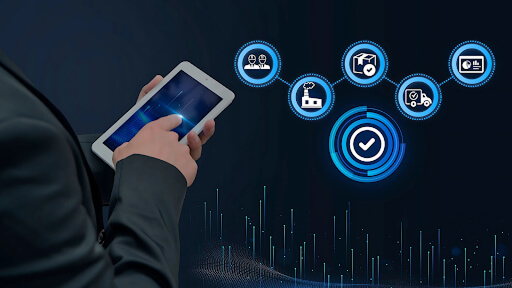 1-800-805-5783
1-800-805-5783 
Supply chains today are under immense pressure. Global instability, shifting demand, port congestion, and supplier risks have made traditional supply chain management models insufficient. Static processes and linear planning simply can’t keep up with today’s complexity. That’s why businesses are turning toward a more dynamic, intelligent solution: Agentic AI in supply chain operations.
This new wave of artificial intelligence isn’t just smarter, it’s proactive, autonomous, and capable of adapting in real time. In short, it creates self-healing, self-optimizing supply chain networks that can withstand shocks and scale faster. This blog explores what agentic AI is, how it differs from traditional AI, and why it’s becoming a must-have in modern logistics.
Agentic AI refers to intelligent agents that possess a high degree of autonomy. Unlike traditional AI models that are task-specific and reactive, agentic AI systems:
Essentially, agentic AI acts autonomously to achieve its goals, adapting to changing conditions rather than passively waiting for commands. Because of this, it is well-suited for handling intricate and dynamic contexts, such as international supply chains.

The Agentic AI in the supply chain is no longer a linear system; it’s an interconnected network of partners, platforms, data streams, and moving goods. A single disruption can escalate into significant delays or lost revenue. Rigid, rule-based systems can’t adapt quickly enough.
Here’s where Agentic AI in supply chain operations becomes a game-changer. These intelligent agents can operate independently across functions such as:
They continuously monitor conditions, communicate with one another, and take corrective action when necessary without requiring human intervention.
According to a study, 68% of supply chain executives believe AI will be critical to future supply chain operations, while 51% have already started pilot programs involving autonomous agents.
When unexpected events occur, such as weather delays, raw material shortages, or labor strikes, agentic AI agents can detect these disruptions, analyze their impact, and instantly reroute shipments, adjust schedules, or switch suppliers.
Example: A shipment of parts is delayed at a port. An agent can automatically notify production managers, find alternative parts from a different warehouse, and adjust the delivery route, all in real time.
According to a 2023 survey, 43% of companies utilizing AI-enabled logistics reported a 40% reduction in downtime by leveraging self-healing processes.
Unlike systems that react only to alerts, agentic AI in the supply chain is driven by long-term goals, such as minimizing costs or maximizing on-time delivery. Agents assess multiple trade-offs and continuously optimize decisions.
Agents work with live data from:
They don’t wait for human analysis. Instead, they act immediately to resolve exceptions and seize opportunities.
Gartner reports that organizations with real-time Agentic AI in supply chain systems experience 25% faster exception handling and a 22% improvement in order accuracy.
Multiple agentic AIs can operate in tandem to manage a domain while coordinating across the broader Agentic AI in the supply chain. For instance:
Together, they orchestrate outcomes that traditional, siloed systems can’t.

Agentic AI in the supply chain can monitor sales trends, warehouse stock, and lead times to rebalance inventory across distribution centers, ensuring high availability with minimal overstock.
McKinsey found that AI-driven inventory optimization leads to a 20–30% improvement in inventory accuracy and up to 50% fewer stockouts.
When traffic, weather, or fuel prices change, agents reroute freight using optimal transport modes without waiting for planner intervention.
A pilot project by DHL utilizing AI agents for dynamic route management achieved a 15% reduction in last-mile delivery times.
Agents monitor supplier behavior, payment terms, geopolitical developments, and compliance data to ensure adherence to regulations. If risk increases, they alert stakeholders or suggest alternative sourcing.
According to Dun & Bradstreet, 48% of supply chain disruptions stem from tier-2 and tier-3 suppliers, precisely where agentic AI brings deep visibility and proactive risk control.
Within smart factories, agentic AI helps schedule machines, shift labor, manage quality control, and align with external logistics in alignment with production goals.
Siemens reported that using agentic AI in factory automation resulted in a 25% reduction in operational delays and a 10% increase in output efficiency.
AI agents validate contract terms in real-time, monitoring shipment specs, SLAs, pricing, and penalties to ensure vendors stay compliant.

The adoption of Agentic AI in the supply chain isn’t just a prediction; it’s already happening on a large scale. Recent industry studies highlight its growing importance:
Agentic AI is reshaping the future of logistics and supply chain resilience.

No breakthrough comes without challenges. While agentic AI offers tremendous potential, companies need to plan for:
Data Availability & Quality
Agents require access to accurate and timely data across various systems. Integrating legacy platforms can be a barrier.
Governance & Control
Autonomous decisions must align with compliance policies and business strategy. Governance frameworks are critical.
Human Oversight
Agentic AI doesn’t replace supply chain professionals; it changes their role. Teams will shift from task execution to strategic decision-making and system supervision.
Skills Gap
New tools require new capabilities. Companies must invest in training, change management, and digital fluency.
According to a survey, 46% of executives identified talent shortages as the top barrier to the adoption of Agentic AI in supply chains.

As AI agents evolve, supply chains will increasingly resemble living systems, flexible, adaptive, and self-optimizing. In the future:
This is the vision of a zero-touch Agentic AI in supply chain, where intelligent agents make day-to-day decisions while humans focus on exceptions and innovation.
Agentic AI in supply chain ecosystems is the next leap forward. It’s not about replacing people with creating faster, safer, and more intelligent systems that can navigate change with resilience.
The transition from conventional, rule-based Agentic AI in supply chains to self-governing, intelligent networks represents a fundamental shift rather than merely a technological advancement. And it is currently taking place.
Agentic AI enables firms to achieve agility, responsiveness, and the ability to self-correct, thereby eliminating costly delays in supply chain processes. The goal is to transition from static alerts and dashboards to systems that can think and act.
1. Is agentic AI different from traditional AI in supply chains?
Yes. Traditional AI performs specific tasks (like forecasting), while agentic AI sets goals, learns, and acts independently.
2. Can agentic AI fully replace human decision-making?
No. It’s designed to support and enhance human decisions, not replace them entirely. Human oversight remains crucial.
3. What kind of ROI can companies expect?
Many report cost reductions of 15–30%, faster delivery times, and improved inventory efficiency within the first year.
4. How can I start implementing agentic AI in my supply chain?
Begin with a single use case, such as inventory planning or supplier risk, and expand gradually. Ensure your data systems are integrated and clean.
At [x]cube LABS, we craft intelligent AI agents that seamlessly integrate with your systems, enhancing efficiency and innovation:
Integrate our Agentic AI solutions to automate tasks, derive actionable insights, and deliver superior customer experiences effortlessly within your existing workflows.
For more information and to schedule a FREE demo, check out all our ready-to-deploy agents here.